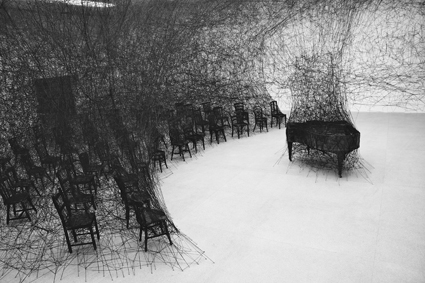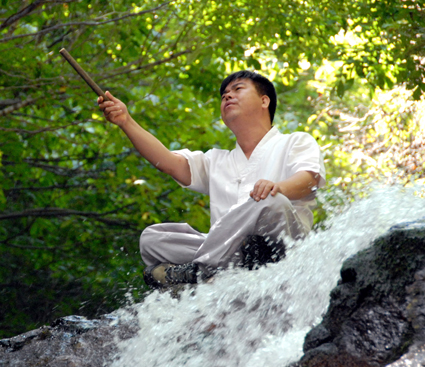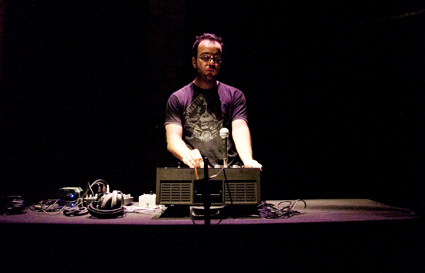expanding the aural palate
gail priest: interview, brian ritchie, mona foma curator

Chiharu Shiota, Biel Klavier
photo courtesy the artist
Chiharu Shiota, Biel Klavier
WHEN BRIAN RITCHIE IS NOT CURATING THE MONA FOMA FESTIVAL OR TOURING WITH ONE OF HIS BANDS, HE IS RUNNING A TEA SHOP WITH HIS WIFE IN HOBART. DISCUSSING THE MENU HE SAYS “THERE’S THIS DISH CALLED NATTO. IF YOU TELL A JAPANESE PERSON ‘I LIKE NATTO,’ THEY SAY ‘NO, WESTERNERS CAN’T EAT THAT, IT’S ONLY FOR JAPANESE.’
“We put that on the menu and just call it soybeans and a lot of vegetarians and other people order it, unsuspecting. They say ‘This is wonderful, I love this,’ because nobody has told them that they’re supposed to be afraid of it.” It seems Ritchie’s culinary strategies perfectly reflect his curatorial approach to MOFO—one of the most interesting Australian festivals to emerge for quite some time.
The Museum of Old and New Art Festival of Music and Art (MONA FOMA, or MOFO for short) landed in 2009, as Ritchie puts it, “like a meteor smacking into Tasmania.” In 2008 Salamanca Arts Centre approached the then studio resident Ritchie (the former bass player of Violent Femmes had recently relocated to Hobart) to curate a music festival. Initially Ritchie said no, but “then of course my ego got in the way and I thought, ‘well, if I had a festival what would it be like?’ and I started to fantasise. I drew up a proposal for something that looks remarkably similar to MONA FOMA, and we went to David Walsh looking for sponsorship money.” Walsh, owner of Moorilla, one of Tasmania’s oldest wineries, has a history of arts philanthropy, including an ongoing relationship with BalletLab (see interview with Phillip Adams) and has been building the Museum of Old and New Art to house his extensive art collection. Along with marketing manager Lee Carmichael, Walsh decided that rather than sponsor the event, he’d like to partner it. With this backing, the Tasmanian State Government also came on board and by January 2009—a remarkably short turn-around time—the first MONA FOMA was thrilling Hobart’s locals and visitors.
an experimental flavour
While billed as a festival of music and art, music is the primary focus, with the performance and visual art elements of the program exhibiting a strong reliance on and collaborative approach to sound. However, unlike the majority of music festivals in Australia, MOFO is decidedly genreless—alternative rock/pop sits happily beside jazz, classical, world music, experimental electronic, improv and sound art. The broadest sweep indicates that there is an emphasis on instrumental rather than vocally driven music but the programming really takes its flavour from Ritchie’s appreciation of and search for the experimental across this broad range of styles. This allows for the mingling of international headline artists like Nick Cave, John Cale and Philip Glass with Australia’s most interesting, emerging and established experimentalists.
Ritchie points to a challenge: “Music is the comfort food of the arts…[It’s] the artform where people are trying to re-live something. That’s the reason 50,000 people will go to something like U2. It’s comforting for them.” Therefore, “one of the things we pride ourselves on,” says Ritchie, “is packaging the content of the festival in a really engaging fashion—to get people to listen to music that they’re not familiar with.
“Mostly we present unknown artists, or in some cases known artists, doing new things—[allowing] them to explore various facets of their creativity. For example last year we had John Cale. Everybody knows that John Cale is from The Velvet Underground, but [for MOFO] he played rock music, he played some classical music, he did some solo improvised piano, he did an art installation. You’re seeing a lot of different sides of John Cale that you don’t normally see.”
The MOFO team seem quite skilled at creating a sense of openness that invites audiences to try new things, from the clever juxtapositions within programming to the laidback, unpretentious marketing copy. Ritchie says, “A lot of times I think people are kind of defensive about what they’re putting out there in front of the public. ‘You might not like this,’ or ‘this is going to challenge you.’ How do you know? It’s presumptuous to assume that people are going to be challenged by something. Maybe people are going to say, ‘Wow, this is what I’ve been waiting for my whole life. Why haven’t I heard this before?’ In fact people have told me that.”

Bae Il-dong
photo Emma Franz
Bae Il-dong
the menu
The 2011 program is still taking final shape, but Ritchie is able to share several highlights. One of the high profile artists this year, as mentioned, is Philip Glass. Nick Cave will be returning to MOFO with his compatriots Warren Ellis, Martyn P Casey and Jim Sclavunos, as the Grinderman, to present their swampy, epic tales. Also from the more popular, yet gritty end of the spectrum will be the Jon Spencer Blues Explosion.
Melbourne’s Speak Percussion celebrate their 10th birthday with a massive percussion orchestra installed around the Princes Wharf venue presenting an all-percussion program including Edgar Varese’s Ionisation, along with a world premiere of a work composed by Anthony Pateras (who will also appear in MOFO with the Pateras/Baxter/Brown trio).
Ritchie is particularly excited about Chiri, a collaboration between renowned Australian jazz musicians Simon Baker (drums) and Scott Tinkler (trumpet) and traditional Korean singer Bae Il-dong, whose technique was acquired by singing into a waterfall 18 hours a day for seven years. Ritchie, a shakuhachi player himself, is no stranger to the difficulty of such cross-cultural musical mixes and considers this a particularly exciting fusion of world music and jazz.
In quite a different exploratory vein, Australia’s Jon Rose will return after last year’s cycling concert (RT90, p48) with another interactive experience—a giant ball that responds to audience play—as well as performing in virtuoso violinist mode. Other Australian artists include the Necks, the much beloved improv trio of Tony Buck, Lloyd Swanton and Chris Abrahams; Philip Samartzis, who will present his latest installation based on field recordings from Antarctica; and the audiovisual duo Botborg, who will induce hallucinations with their frenzy of sculptured static. Local Tasmanian electro-synth group Scientists of Modern Music will also play their home town as will SS2Q, an up and coming classical chamber ensemble.
While music is the focus, the gallery-based installations have been a highlight of previous festivals. Co-curated by Nicole Durling from MONA, this year’s program offers a range of impressive works including Australian Indigenous artist Brook Andrew’s Op-Art jumping castle (seen at the 2010 Biennale of Sydney) and Berlin-based Japanese artist Chiharu Shiota’s suspended, burnt-out piano inviting silent contemplation. Nor is the body forgotten with the inclusion of Philip Adams’ BalletLab presenting a trilogy of works: Above, Miracle and Amplification (see the interview with Adams, p23).

Anthony Pateras
photo courtesy MOFO
Anthony Pateras
a bonus course
After a week of MOFO activities in the heart of Hobart, the action will then move to the Moorilla Estate for the long awaited opening of the Museum of Old and New Art—a 6,000 square metre “secular temple” built to display David Walsh’s extensive collection of antiquities and contemporary marvels, exploring sex and death and everything in between. There’ll be more performances with concerts by the UK band Wire and Health from the US, a pyrotechnical spectacle by Groupe F from France, a “live car-crash sculpture” by Swiss artist Roman Signer, plus the provocations of Singapore-based Serbian performance artist Ana Prvacki.
a different kind of cooking
One of the most important aspects of MOFO is that the majority of performances (bar some of the headliners) are completely free. But Ritchie maintains, “You still have to engage [the audience], and draw them in, because people’s time is valuable.” Furthermore, the fact that MOFO is largely funded by private money perhaps frees it from some bureaucratic imperatives. Ritchie says, “I think there’s kind of an orthodoxy in the arts here—even the experimental arts—a way of doing things, and ticking boxes that we don’t really have to do…People are looking at us thinking, they’re not playing by the rules.”
What Ritchie wants to do in future festivals is offer more project-based creations like last year’s 48 Fugues for Frank, a collaboration with Michael Kieran Harvey and four visual artists [RT96, p40] celebrating the music of Frank Zappa. He says, “This year we have something like that with Tormented Gong by the Hong Kong New Music Ensemble and visual artist Samson Young. Next year we’ll have an opera we’ve commissioned. That’s the direction I’d like to go in rather than having a bunch of people doing their usual gigs.”
Ritchie is inspired to create these projects because he is deeply impressed by some of the great artists he’s found in Australia, like Michael Kieran Harvey, Eugene Ughetti, Robin Fox and Anthony Pateras. “It’s really fun to be able to get them to do what they want to do. A lot of the times artists say ‘What do you want from me, what do you want me to do?’ I say to them, ‘Do what you want to do.’ Sometimes they say ‘I’d like to have a triple orchestra’ [laughs]—but if it’s something that’s doable I like to just let them run with their ideas. When you give these artists a free hand then they usually come up with something dazzling.”
MONA FOMA, Hobart, Jan 14-20, MONA opening, Jan 21-23; www.mofo.net.au
RealTime issue #100 Dec-Jan 2010 pg. 11






